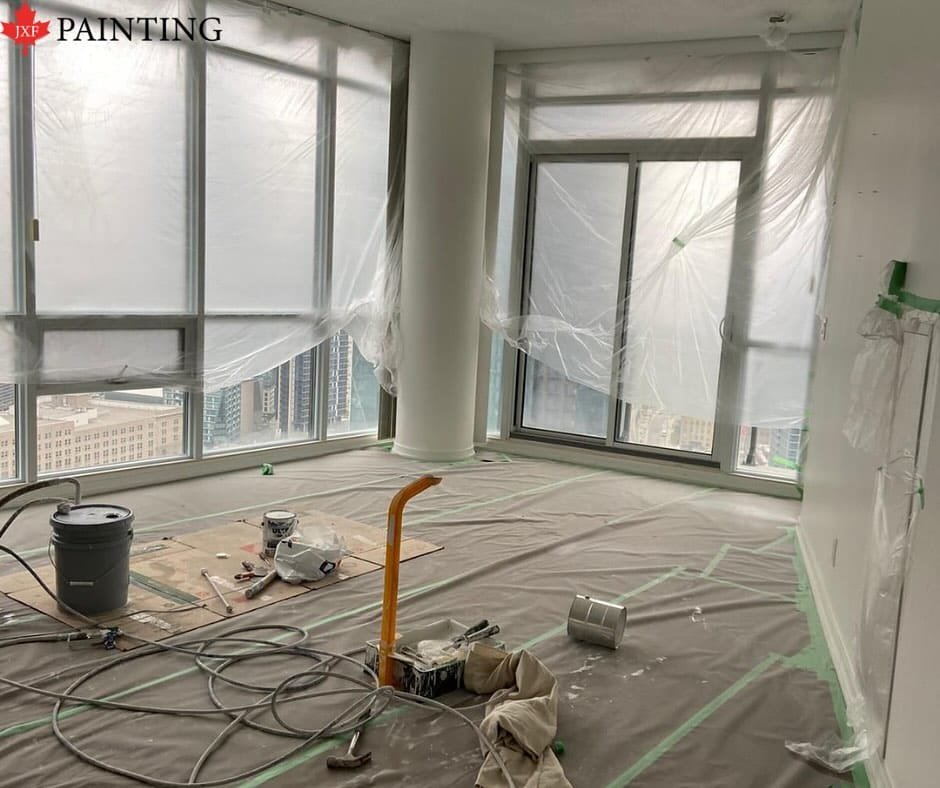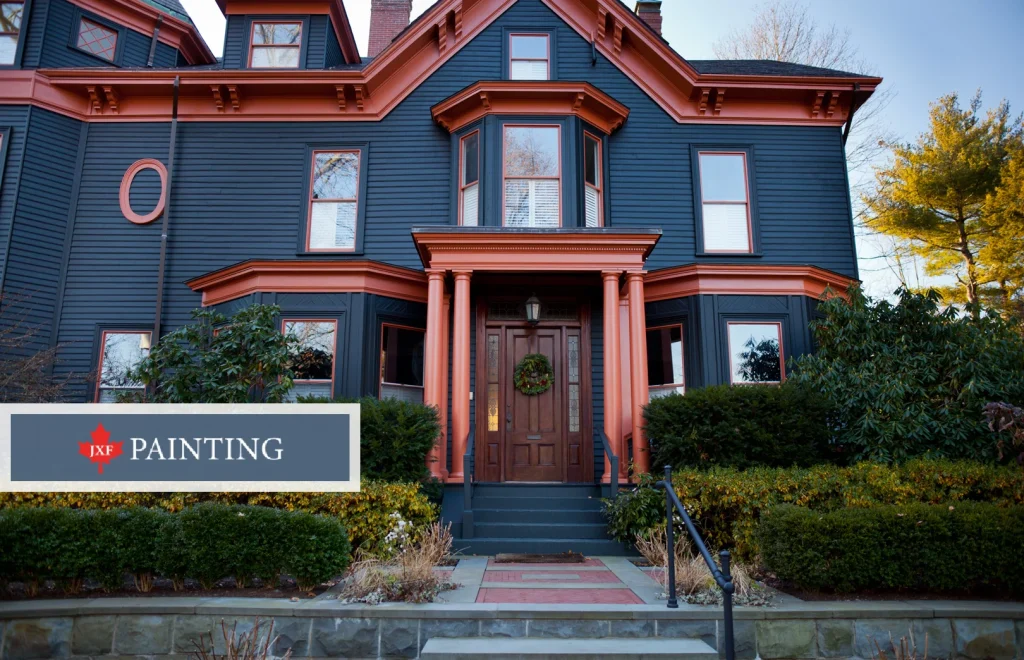Have you just painted the outside trim or walls and wondered if you may use external paint inside? Or perhaps you believe it would be preferable to use it in the bathroom, given the humidity? Although it may appear an excellent idea, exterior paint is used for a purpose.
Exterior paint should not be used indoors. It has a higher concentration of VOCs (Volatile Organic Compounds), colours, additives, and binders. Even after drying, the finish is softer and more flexible, emitting hazardous vapours. It can make humans and dogs sick, and the result isn’t as appealing.
We’ll look at what exterior paint is, if it can be used indoors and whether it’s safe to apply on interior surfaces in this post. We’ll also talk about combining interior and outdoor paint. When you’re done reading, you’ll have a better grasp of exterior colour and whether or not it’s OK to apply indoors.
What Exactly Is Exterior Paint?
Exterior paints are made to survive scorching heat, sandblasting winds, torrential downpours, and bone-chilling cold. It must survive the environment and not fade, peel, crack, or enable mould and mildew to grow when applied to buildings, structures, and outdoor surfaces.
High-quality flexible resin binders in better exterior paint stretch and shrink with the surface they cover. There is a combination of ingredients for levelling and staining, fading, and mildew resistance. Most outdoor colours contain UV protection to help the pigments retain their colour. Exterior paints include more resins and are softer than interior paints, allowing them to adapt to temperature and climatic extremes.
Outdoor paints are available in both oil and water-based formulations. The base is the evaporating solvent, while the binders keep the pigment and additives together to produce the paint layer. Paints come in various finishes and additives and can be applied with a brush, roller, sprayer, or sponge. Because water evaporates faster than oil, water-based paints often dry faster. Expect to pay extra for high-quality colours that will last 10 to 15 years if done correctly.
Bases
Exterior paints were traditionally oil-based, but current formulas have resulted in certain water-based paints that are as excellent as or better than oil paints. Oil-based paints are made from tung, linseed, soybean oil, or synthetic alkyds, whereas latex or water-based paints are made from water. Oil-based paints emit more VOCs than water-based paints, yet both include harsher compounds. Flat, satin, semi-gloss, gloss, and enamel treatments are available for both base types.
Pigments
Pigments can be biological or inorganic, which gives the paint its colour. White is composed of inorganic elements, most often titanium dioxide, organic comes from plants or animals, and inorganic comes from minerals. Organic pigments are more translucent, and inorganic pigments are more solid. The larger the particle count of the stain, the deeper and more reliable the colour. Exterior paint pigments are designed to resist fading caused by UV, light, and weathering.
Additives
Mineral spirits or water in water-based paints carry and disseminate pigment, additives, and binders. The shades or water evaporate, leaving behind the dried paint film. Additives are anything that is added to paint to make it thicker, fill gaps, level, adhere to different surfaces, be more durable, harden, and resist UV and mildew. It also contains textural and reflective elements and perfumes to disguise the paint’s chemical odours. Exterior paints have different ingredients than interior paints, allowing them to endure harsh weather conditions.
Binders
Binders are the substances that keep pigments and additives together to produce the paint coating on various surfaces. They, too, are designed to endure more challenging outside conditions than those seen on interior walls.
Can Exterior Paint Be Used Inside?
You may have some leftover outside paint or believe that because exterior paint is so durable, it should be suitable for internal usage. While your theory is sound, it ignores the reality that interior and exterior colours are designed for distinct situations. Both types of paint contain mildewcides, fungicides, UV blockers, and other common chemicals, but they are not the same.
Exterior paints are made with chemicals and binders intended to endure more challenging circumstances. They are also made of materials that can be dangerous in enclosed spaces but are less so outside. Exterior paints frequently emit higher VOCs and foul scents, unpleasant in tight quarters. Exterior paint is sometimes more expensive than equivalent-grade interior paints due to the makeup of the ingredients used.
When applying external paints, it is customary to do so in well-ventilated places. The colour will emit VOCs until thoroughly dried, which can take several weeks in warm weather and months in colder weather. It is permissible to use it inside cabanas, sheds, detached garages, and other structures, providing adequate ventilation and not used for sleeping.
Although exterior paint can be used indoors, it is not advised. Interior colours, such as drywall, are intended for interior walls and ceilings. They dry faster and provide a more rigid surface resistant to impacts, scuffs, and harsh cleaning. Exterior paints are designed for use on surfaces other than drywall, and they expand and contract in response to the elements’ thermal and mechanical expansion and contraction. Furthermore, exterior paint frequently has a distinct texture or feel when dry that may not be as appealing within as it is outside.
Is it risky to use outside paint inside?
For various reasons, including expense and quality, it is not suggested to use outside paint on interior walls. The primary reason, however, is connected to your health as a painter and the health of others who occupy the interior space. VOCs (Volatile Organic Compounds) and chemical odours in exterior paints can cause respiratory, neurological, and other problems.
A paint intended for outdoor application must be more flexible and thus softer or rubbery than interior paints. They take longer to cure than interior paints and emit scents long after the surface is dry. Because the scents are outdoors, they usually do not pose a health risk when sprayed. When used in confined locations, however, they become even more deadly.
Exterior paint includes stronger mildewcides and fungicides than interior paints. Mildewcides and fungicides are not the same things in interior colour. Furthermore, the binders and pigments are manufactured using new components more resistant to weathering. Because of the fumes, many professional painters use respirators when applying exterior paint outside, especially when using a sprayer. Standing on a ladder and feeling lightheaded or dizzy is a formula for catastrophe.
When outside paint is applied to inside walls or ceilings, VOCs and chemical fumes are released when ventilation isn’t as excellent as outside. The VOCs are required to retain the pigment in the paint and bind it to the surface where it is applied. They are significantly more dangerous when sprayed with a sprayer than a brush or roller since the fumes are discharged into the air more quickly.
VOCs and chemical scents emitted by outdoor paint harm people and pets. They can induce headaches, dizziness, nausea, inflamed eyes and throat, respiratory problems, and concerns for people with weakened immune systems. Prolonged exposure can potentially result in more severe ailments, including cancer. Central heating and cooling systems may also distribute fumes throughout a home.
Exterior paint scents can persist inside rooms as they oxidize and create health problems long after they have healed. I used outside paint to paint the inner walls of an uninsulated tool shed about five years ago. I reasoned that it would be an excellent solution because the walls stretch and contract in response to temperature extremes. Even though it is adequately ventilated, there are times when I open the door and am assaulted by odours.




